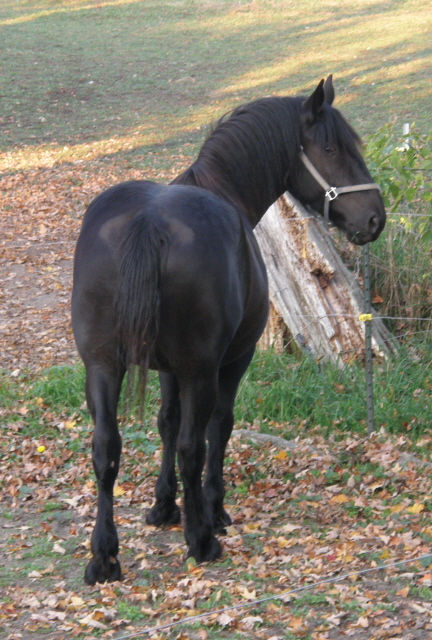Percherons of Color
Black - Grey - Chestnut - Bay - Roan
A Registered Percherons Research Site

Weanling filly. Almost completely shed, notice her lower legs still have sunburned brown hair.

Maggie before she shed. Notice her brown coloration due to both sun and her baby fuzz.

A Percheron mare who is known to not sunfade.

Without sunfading

Wixi naturally sunfades year after year. She always has. Her daughter Indi also fades.

La Rex x Loiselle. ... Miss this mare. Another mare I'd take 5 more of. She has my opinion of an ideal hip. She was just a quality mare, and sadly under utilized as a broodmare. She did have some foals, but the few she had are either deceased, or did not go with papers.
There are two genetic types of Black: Homozygous Black (EE) and Heterozygous Black (Ee).
Horses who are (EE) will always produce Black based foals no matter what they are bred to. The choices would be only Black, or Bay (only if they are bred to a Bay horse, or a Grey horse hiding the Bay gene).
Example: A Homozygous Black (EE) bred to another Homozygous Black (EE) will produce foals that are 100% Homozygous Black 100% of the time.
A Homozygous Black (EE) horse bred to a Heterozygous Black (Ee) horse will produce Homozygous Black Horses with a 50% probability, and Heterozygous Black horses with a 50% probability.
E E
50% of Homozygous Black foals
E
EE EE 50% of Heterozygous Black foals
Each parent contributes one base
e color gene to their foal
Ee Ee
Black is dominant to Chestnut. Horses who are (Ee) and are also mated with another horse who is (Ee) will be able to produce both Black and Chestnut foals. A great example of this are horses decending from Justamere Showtime. Showtime was (Ee), his son Dragano was also (Ee). Many Chestnut Percherons descend from this line multiple times hence creating horses who are heterozygous black and able to produce Chestnut horses. There are multiple lines that carry chestnut in their genetics. With the world of color genetics opening up more and more all the time, Percherons could be tested for chestnut via the Red Factor Test to determine whether they will produce a chestnut or not. The Red Factor Test will test for the Base Colors, being black, and chestnut.
You will also notice that white markings are least on black horses.That is because Black suppresses white markings. The Chestnut Percherons will in "most" cases show more white markings than their Black relatives. This is known in all breeds, not just Percherons.
Black Percherons are typically born a mousey brown color with an almost blueish cast at times. As shown by the examples to the left, some black's will sun fade, and others do not. Sun fading is typically due to environment, genetics, health, or any of the above combined.
With Black Percherons being the highest registered color in the United States and Canada, it is easily the most attainable color in the breed. Black Percherons are desired in the United States and Canada as they are easy to match in color to make up teams of horses. Even a very large portion of Grey Percherons are Base colored Black. It simply has become the color most desired in America and Canada. One must admit that a team of nice looking black horses is fancy indeed.